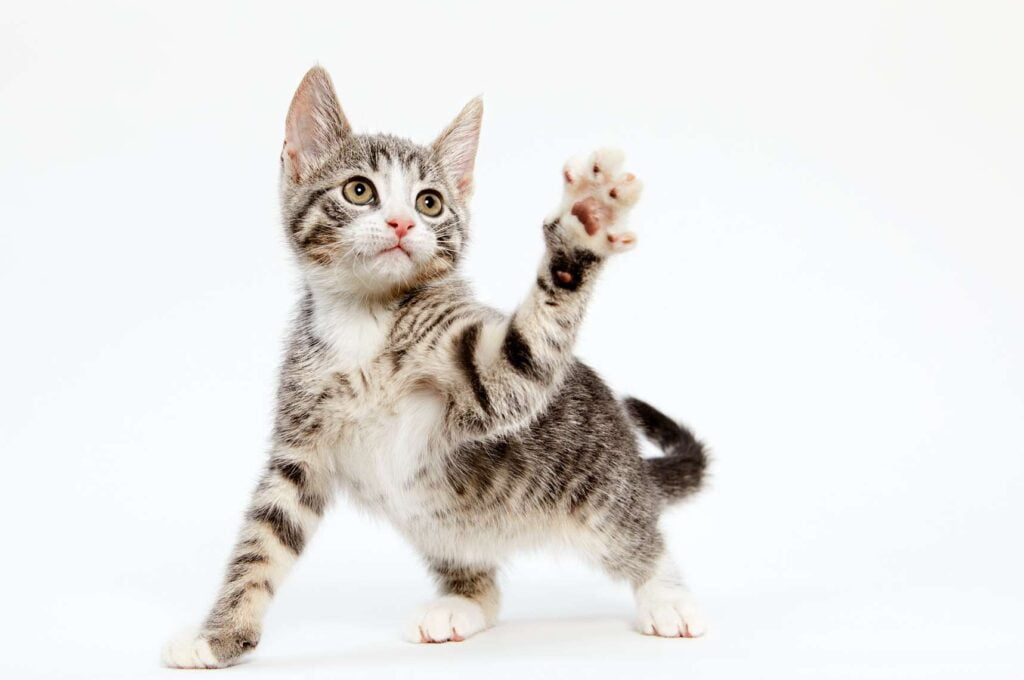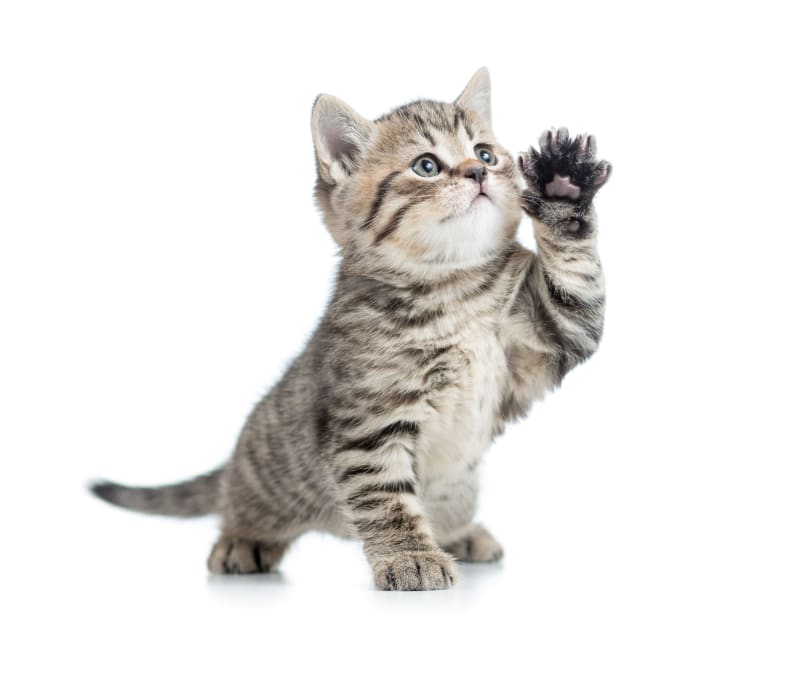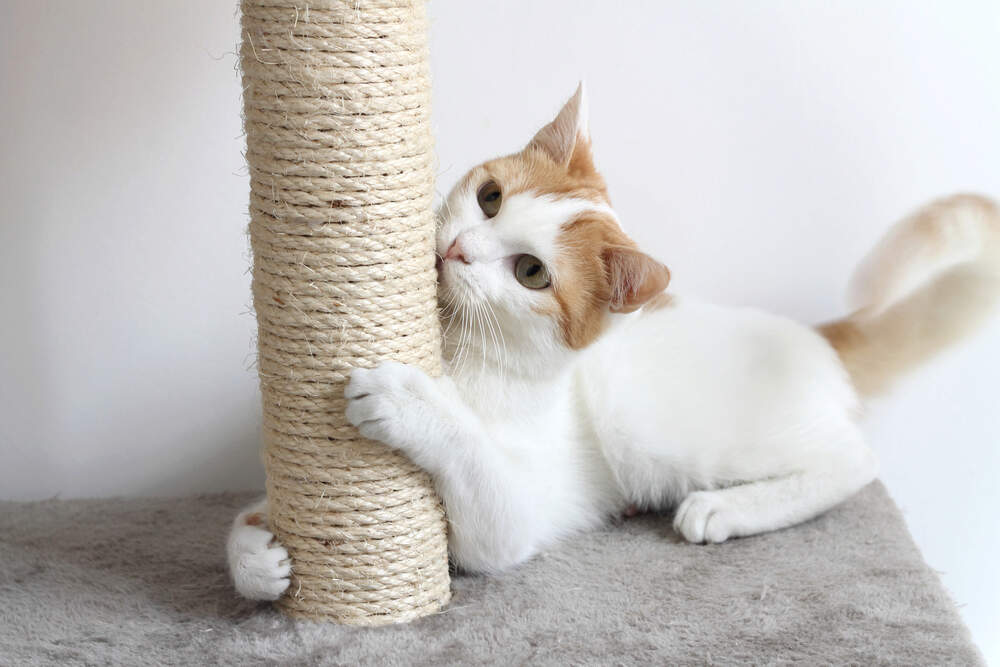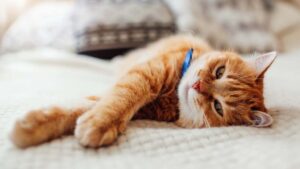How to Stop Your Cat from Pawing at You

Do you want to know how to stop your cat from pawing at you?
Cats are cute, cuddly and make great companions, but sometimes their behavior can be a bit overwhelming, especially when they paw at their owners. This can be quite annoying and even painful if your cat has sharp claws. But why do cats paw at their owners in the first place?
Understanding the reasons behind your cat’s behavior is the first step in resolving the problem. In this article, we’ll explore the different reasons why cats paw at their owners and what you can do to stop it.
Why Do Cats Paw At You?

There are multiple reasons for why your cat may be pawing at you. It may seem like an attack, but instead it is actually a communication method that cats use to let you know how they are feeling. Here are some of the reasons why cat may be pawing at you:
Attention Seeking & Boredom:
Cats have a knack for seeking attention, and when they paw at their owners, it’s often a way of expressing their desire for companionship. This behavior can stem from feelings of loneliness or boredom. When a cat craves interaction and playtime, they may resort to gently tapping their paws on you to grab your attention. Furthermore, if your pet cat is feeling hungry or longing for some affectionate petting, they might employ their paws as a means to communicate their needs.
Marking Territory:
Pawing behavior in cats can also serve as a means of marking territory. Within their paws, cats possess scent glands that secrete pheromones, which are chemical substances used for communication. When a cat feels insecure or senses a threat to their territory, they may resort to pawing at you or objects within your home to establish their dominance and assert their presence.
Pain or Discomfort:
Sometimes, when cats paw at you, it may indicate that they are in pain or experiencing discomfort. Whether it’s from an injury, illness, or any other physical issue, your cat may paw at you as a way of seeking comfort and relief. If you observe this behavior and suspect that your cat might be in distress, it is crucial to consult a veterinarian for a thorough medical examination. They can assess your cat’s health, identify any underlying issues, and recommend appropriate treatment to alleviate their pain or discomfort.
Communication:
Cats often paw at their owners as a means of communication, expressing their desires and needs in a non-verbal manner. This form of feline interaction can serve various purposes. For instance, your cat may gently paw at you, indicating a longing for affectionate petting or seeking attention. Similarly, they might employ their paws to communicate their hunger, subtly requesting food or treats.
Solutions to Stop Your Cat from Pawing at You

If you don’t address the problem behind why your cat is pawing at you, then this behavior may escalate further. Once you have identified the problem, implement the solution.
Provide Enough Attention and Interactive Toys:
To address your cat’s pawing behavior for attention, it is crucial to ensure they receive ample attention and engagement. Spending quality time with your feline friend, engaging in play sessions, and offering affectionate interactions can help fulfill their need for companionship. Additionally, providing a variety of interactive toys, such as puzzle toys, feather wands, or treat-dispensing toys, can keep them mentally stimulated and entertained.
By meeting their need for attention and offering stimulating toys, you can reduce your cat’s inclination to paw at you for attention. Remember to rotate and introduce new toys periodically to keep their interest piqued. Creating an enriching environment that caters to their physical and mental stimulation is key to redirecting their pawing behavior and promoting their overall contentment.
Get a Playmate
If you find it challenging to provide your cat with the attention it craves, one option to consider is adopting another feline companion. Introducing a new cat into your household can offer a valuable distraction for your cat and keep them occupied with a playmate. Having a fellow feline around can fulfill their social and interactive needs, reducing their reliance on pawing for attention.
However, it is crucial to ensure a gradual and proper introduction process, allowing both cats to adjust and establish a harmonious relationship. Monitoring their interactions and providing separate resources like food bowls and litter boxes will help facilitate a smooth integration and create a stimulating environment for both cats to thrive in.
Train Your Cat to Stop Pawing:
Training your cat to curb pawing behavior can be achieved through positive reinforcement techniques. By rewarding your cat with treats or praise when they refrain from pawing and ignoring them when they do engage in pawing, you can shape their behavior over time. Consistency is key to success, as your cat will gradually learn that pawing does not yield the desired attention, while exhibiting alternative behaviors may result in positive reinforcement.
When your cat refrains from pawing, offer them a treat or engage in interactive playtime to redirect their focus. Conversely, when they do paw, withhold attention and avoid reacting to discourage the behavior. Patience and repetition will reinforce the message that pawing is not an effective means of obtaining attention. Through this positive reinforcement approach, your cat can learn alternative ways to communicate their needs and desires, fostering a more harmonious and mutually satisfying relationship.
Address Any Physical Discomfort:
If your cat’s pawing behavior is due to pain or discomfort, it is crucial to address the underlying cause to alleviate their distress. Scheduling a veterinary check-up is essential for a thorough examination and proper diagnosis. Based on the vet’s recommendations, administering pain relief medication or implementing changes to their environment can provide relief.
Ensuring a comfortable and safe space for your cat, such as providing cozy bedding, a quiet area, or temperature control, can contribute to their overall well-being. Additionally, modifying their diet or introducing supplements, if advised by the vet, can help manage any underlying health issues that may be contributing to their discomfort. By proactively addressing their physical needs, you can help reduce their pawing behavior and improve their quality of life.
Consider Declawing:
In some cases, declawing may be necessary to stop your cat from pawing at you. However, this should be a last resort and only considered after other methods have been tried and failed. It’s important to talk to your vet about the potential risks and benefits of declawing before making a decision.
Instead of declawing, it might be better for you to give up the cat for adoption. It might find a better home where it can be comfortable, or an owner who can knows how to handle it better. Remember to keep your cat’s feelings in mind too, not just yours.
Conclusion
In conclusion, cats employ pawing as a multifaceted means of communication, encompassing attention-seeking, territorial marking, expressing pain or discomfort, and general communication of needs. By attentively observing and comprehending your cat’s behavior, you can discern the underlying motives behind their pawing and take appropriate actions to address them.
Whether it involves providing ample attention and interactive toys, seeking veterinary care for any potential health concerns, considering the addition of a playmate, or utilizing positive reinforcement training techniques, understanding your cat’s unique needs and responding accordingly fosters a harmonious and fulfilling relationship. By nurturing their well-being and effectively addressing their pawing behavior, you can forge a deep bond and enjoy the companionship of your beloved feline companion.


